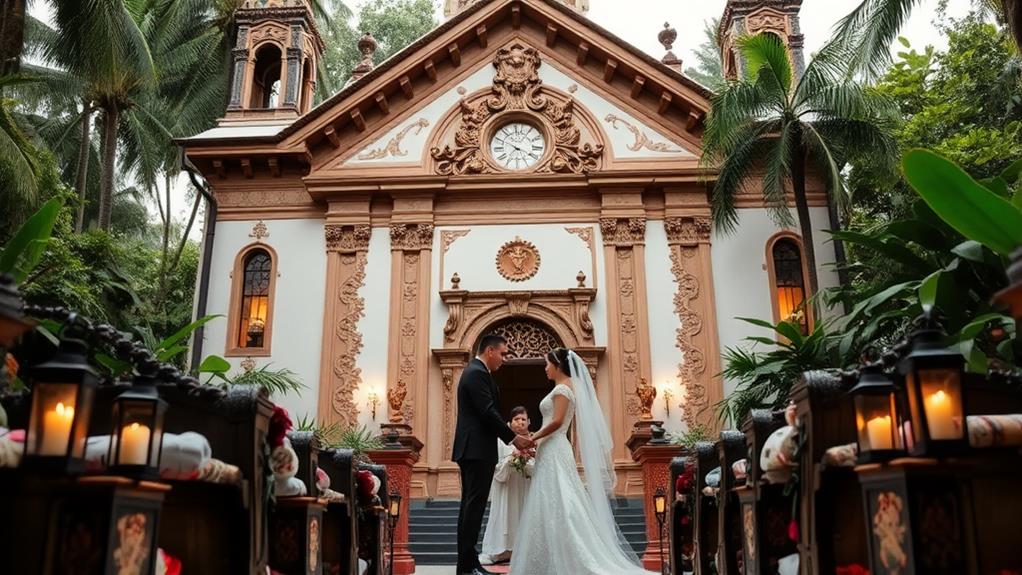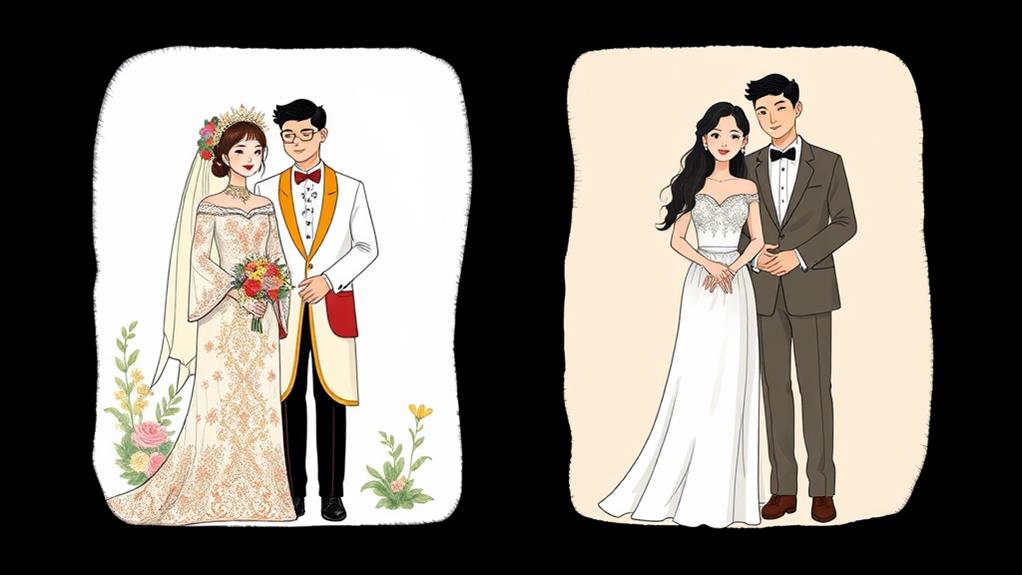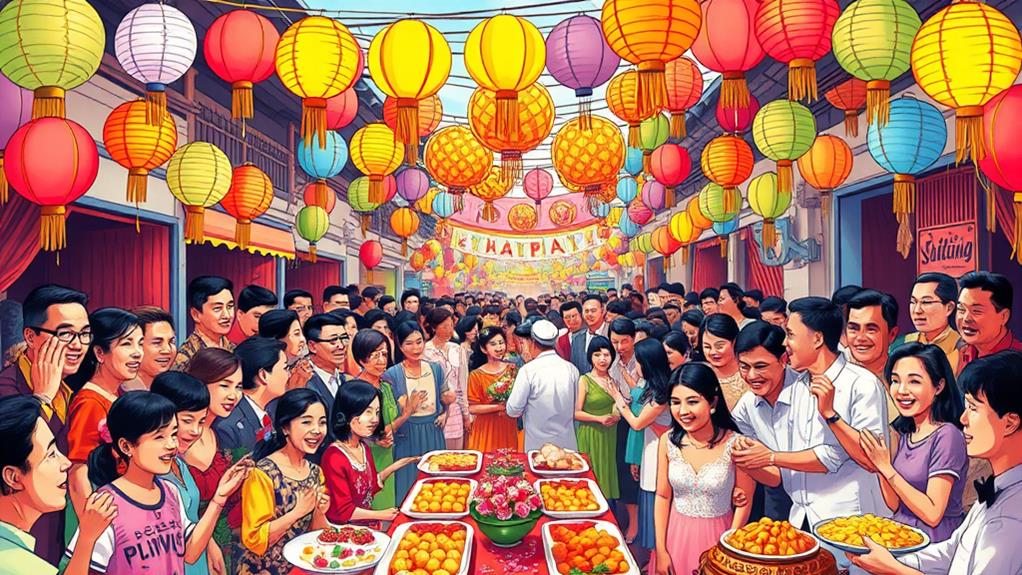Filipino wedding customs are a unique blend of indigenous, Spanish Catholic, and modern influences. The country's history and Catholicism have shaped its wedding traditions.
Pre-colonial ceremonies and Catholicism are the historical roots of Filipino wedding customs. The Pamamanhikan, where the groom's family requests the bride's hand, is a significant part of the tradition.
Another important part is the Despedida de Soltera, a farewell party for the bride.
Traditional attire has evolved over time. The Barong Tagalog, a traditional men's garment, and the Maria Clara gown, a traditional women's garment, have modern twists.
Symbolic elements, such as the Arras and Veil ceremonies, remain vital.
Filipino wedding customs have a rich cultural heritage that inspires contemporary celebrations. This heritage continues to influence modern weddings, blending tradition and modernity.
Historical Roots of Filipino Weddings

Filipino weddings are a unique blend of indigenous and Spanish Catholic influences. This blend is a result of over 300 years of colonization, which transformed the country's matrimonial traditions.
Pre-colonial marriage ceremonies lasted three days and were officiated by a babaylan, a spiritual leader who performed rituals like blood mixing and blessings from ancestors.
The introduction of Catholicism changed wedding practices, emphasizing the union of families and the importance of public ceremonies sanctioned by religious authorities.
Traditional customs, such as the pamamanhikan, highlight the importance of familial respect and community involvement. During the pamamanhikan, the groom's family formally requests the bride's hand in marriage, demonstrating respect for the bride's family and community.
Modern Filipino weddings reflect a fusion of historical traditions and contemporary elements.
Rituals like the exchange of Arras coins and the Veil and Cord ceremony are still maintained, symbolizing unity and commitment.
Western attire and practices have also been incorporated, making Filipino weddings a unique blend of old and new.
Pre-Wedding Rituals and Traditions
Filipino weddings typically involve a series of pre-wedding rituals and traditions that set the tone for the big day.
Family involvement is a key aspect of these customs.
The Pamamanhikan is a formal visit where the groom's family seeks the bride's family's permission for marriage, emphasizing respect and unity. This custom highlights the importance of family approval in Filipino culture.
The Paalam ceremony marks a significant step in the engagement process, as the groom announces his marriage intentions to the bride's family. This tradition formalizes the groom's commitment to the bride and her family.
Before the wedding, a Despedida de Soltera farewell party is often held to celebrate the bride's transition to married life. This gathering usually combines with family reunions, honoring her familial ties.
The Pamanhikan sa Simbahan involves a visit to the church to discuss wedding arrangements with the officiant, highlighting the importance of religious blessings in Filipino marriages.
In the Paninilbihan tradition, the groom showcases his commitment and respect for the bride's family by serving them before the wedding ceremony. This custom demonstrates the groom's willingness to take care of his new family.
These pre-wedding rituals and traditions embody the essence of Filipino marriage customs, blending traditional practices with modern values.
Evolution of Traditional Wedding Attire

Filipino Wedding Attire: A Blend of Tradition and Modernity
The traditional Barong Tagalog and Maria Clara gown are iconic symbols of Filipino cultural identity and heritage in wedding attire. The Barong Tagalog, worn by grooms, is a symbol of cultural pride, while the Maria Clara gown, with its distinctive butterfly sleeves, embodies modesty and grace for brides.
Evolution of the Terno
The Terno, a traditional piece of attire, has undergone modern interpretations while maintaining its cultural significance. This evolution showcases Filipino artistry in wedding fashion, with designs that blend traditional and modern elements.
For example, contemporary designs often incorporate intricate embroidery and vibrant colors, reflecting personal style and cultural pride.
Sustainable Wedding Fashion
Today, many Filipino weddings prioritize sustainability in their attire choices.
Ethically-made and handcrafted garments are increasingly popular, as they celebrate Filipino craftsmanship while promoting environmental responsibility. This shift towards sustainable fashion honors the country's cultural heritage while embracing modern values.
A Beautiful Blend of Tradition and Modernity
Filipino wedding attire has evolved to beautifully blend tradition and modernity.
This fusion of cultural identity, contemporary style, and sustainability results in unique and meaningful attire that reflects the couple's personality and values.
Symbolic Ceremonial Elements
Symbolic Ceremonial Elements in a Traditional Filipino Wedding
In a traditional Filipino wedding, symbolic ceremonial elements play a significant role in reinforcing the couple's unity, commitment, and shared responsibilities.
The Arras ceremony is a vital element, where the groom presents 13 coins to the bride, symbolizing his promise to provide for their future. This represents financial stewardship and commitment in the marriage.
The Veil and Cord ceremony is another important ritual, where a veil is draped over the couple to symbolize their unity and protection. The cord, shaped in a figure-eight, represents their everlasting bond.
During the wedding ceremony, the Unity Candle is often lit to symbolize the merging of the couple's lives and families, emphasizing the theme of togetherness.
Principal and Secondary Sponsors play vital roles in these rituals, assisting in candle lighting and veil placement, thereby reinforcing the importance of community and family involvement in the celebration.
Modern Twists on Traditional Practices

Modern Filipino Weddings Blend Tradition and Innovation
Filipino weddings have evolved to incorporate modern ideas while preserving traditional practices. Couples are blending traditional attire with contemporary fashion trends, resulting in unique and personalized wedding looks that maintain cultural significance.
For example, the Barong Tagalog and Filipiniana gown are being paired with modern twists, such as bold colors or non-traditional fabrics.
Wedding Ceremonies Reflect Individuality and Cultural Diversity
Modern wedding ceremonies often incorporate diverse cultural elements and personalized touches. Unity ceremonies and personalized vows are becoming increasingly popular, reflecting a trend towards individuality and self-expression.
Traditional rituals, such as the Arras and Veil ceremonies, are still observed, but couples are adding personal touches, like custom coins or unique veil designs, to make them more meaningful.
Sustainable Practices Take Center Stage
Filipino couples are also embracing sustainable practices to reduce their environmental impact. Eco-friendly venues, digital invitations, and locally sourced catering are gaining popularity, allowing couples to celebrate their heritage while minimizing their footprint.
This shift towards sustainability reflects a growing awareness of the importance of environmental responsibility.
Filipino Wedding Inspiration and Trends
Filipino weddings now blend cultural heritage with modern style and social responsibility.
Modern Filipino weddings incorporate sustainable fashion choices, such as ethically-made jewelry and accessories that highlight Filipino artistry. Traditional attire like the Barong Tagalog and Maria Clara gown gets a modern twist with contemporary design elements that retain cultural significance.
Inclusivity is key in modern Filipino weddings. Couples use live-streaming technologies to ensure loved ones who can't attend in person can still share in the wedding experience.
The revival of indigenous practices and traditional rituals, such as the exchange of Arras coins and the Cord and Veil ceremony, allows couples to reconnect with their cultural roots.
Eco-friendly venues and digital invitations are gaining popularity. This trend reflects a commitment to environmental consciousness while honoring cultural heritage.
Community Involvement and Celebrations

Community Involvement in Filipino Weddings
In Filipino weddings, community involvement plays a vital role in the celebrations and traditions.
Family and friends are actively involved in various preparation tasks, such as cooking, decorating, and organizing ceremonies. This collective effort strengthens familial bonds and community ties.
The Pamamanhikan: A Formal Meeting
The Pamamanhikan, a formal meeting between the families of the bride and groom, serves not only to discuss wedding plans but also to strengthen familial bonds and community ties.
This meeting reinforces the collective role of the community in the couple's new life.
Traditional Practices at the Wedding Reception
During the wedding reception, traditional practices like the Money Dance, where guests engage in supporting the couple financially, emphasize the collective role of the community in the couple's new life.
Guests often contribute to the celebration by bringing traditional dishes, showcasing the rich culinary heritage of the Philippines and fostering a sense of community through shared meals.
Cultural Celebrations and Symbols
Cultural celebrations, such as the release of doves, symbolize community wishes for peace and harmony in the couple's married life, reinforcing collective support and family ties.
How Do Filipino Wedding Customs and Traditions Reflect the Community’s Faith and Values?
Filipino wedding customs and traditions are deeply rooted in the celebration of filipino faith and values. From the pamamanhikan to the exchange of coins and veils, each ritual symbolizes the couple’s commitment to each other and to their community. These customs highlight the importance of family, respect, and unity in the celebration of Filipino faith.
Blending Heritage With Modernity
Modern Filipino weddings blend heritage with modernity. This fusion is evident in the attire, where traditional pieces like the Barong Tagalog and Maria Clara gown are paired with modern elements, such as the bride wearing a white gown or the groom donning a tuxedo.
Sustainable practices are incorporated into wedding planning. Eco-friendly elements, such as sustainable venues and digital invitations, are being used to reduce environmental impact. This shift showcases a growing awareness of the importance of protecting the environment.
Traditional rituals are merged with modern practices. Ceremonies like the Veil ceremony and Arras are combined with modern elements, such as live-streaming the event for remote family and friends. This allows for greater inclusivity and accessibility.
The role of Ninongs and Ninangs has evolved. While still maintaining their importance as sponsors, their involvement in wedding festivities has modernized, highlighting the importance of community support and adaptability.
Filipino weddings today are unique celebrations of individuality and tradition. By blending cultural heritage with contemporary practices, couples create memorable and personalized weddings that honor their roots while embracing modernity.
Frequently Asked Questions
What Are the Customs of Marriage in the Philippines?
Philippine Marriage Customs Combine Love, Family, and Community
In the Philippines, marriage is a significant event that involves not only the couple but also their families and the community.
The Pamamanhikan is a pre-wedding ritual where the groom's family visits the bride's family to formally ask for her hand in marriage. This custom emphasizes the importance of family involvement in the union.
Financial Commitment is Represented by the Arras Ceremony
During the wedding ceremony, the Arras ritual takes place, where the groom gives the bride 13 coins as a symbol of his commitment to provide for her financially.
This tradition highlights the importance of financial responsibility in marriage.
Unity is Emphasized Through the Veil and Cord
Two important symbols of unity in a Filipino wedding are the Veil and Cord.
The Veil represents the couple's union, while the Cord symbolizes the bond between them, which can't be broken. These symbols are incorporated into the wedding ceremony to emphasize the couple's commitment to each other.
Family Involvement is a Key Aspect of Filipino Weddings
From the pre-wedding preparations to the wedding feast, family members play a significant role in the celebration.
This involvement strengthens family ties and emphasizes the importance of family in Filipino culture.
What Happens in a Traditional Filipino Wedding?
A traditional Filipino wedding is a grand celebration that showcases the couple's commitment to their heritage.
The ceremony begins with a grand bridal procession, where the wedding party walks down the aisle. This is followed by the unity candle lighting, a symbolic act that represents the couple's bond.
The wedding entourage, dressed in elegant attire, participates in the veil ceremony, where the bride's veil is placed over the groom's shoulder to symbolize their unity, and the rice ritual, where the bride and groom are showered with rice to ensure a prosperous marriage.
After the church blessing, the celebration shifts to the reception, where the party atmosphere takes over. One of the highlights of the reception is the money dance, where guests pin money on the bride and groom as a symbol of good luck and prosperity.
Throughout the celebration, family involvement is strongly emphasized, as the couple's commitment to their heritage is put on display.
What Is the Concept of Marriage in the Philippines?
The concept of marriage in the Philippines is deeply rooted in cultural significance. It emphasizes family involvement and communal ties, going beyond just two individuals.
Marriage in the Philippines blends faith and spirituality with societal expectations. This is evident in engagement traditions like pamamanhikan, where the groom's family visits the bride's family to ask for her hand in marriage.
Wedding rituals are steeped in tradition, with practices like dowry, where the groom's family gives gifts to the bride's family as a symbol of respect.
Legal requirements for marriage in the Philippines include age and CENOMAR (Certificate of No Marriage Record). The age requirement is 18 years old for both men and women, while the CENOMAR ensures that neither party has been previously married.
Filipino marriage is a rich tapestry of marital roles, faith, and cultural heritage. It emphasizes the importance of family, community, and spirituality in building a strong and lasting union.
What Are Modern Weddings and Traditional Weddings?
Modern weddings prioritize personalization and flexibility. They often incorporate technology to live-stream the event, allowing guests who can't attend in person to participate.
Couples also have the freedom to choose unique venues and reception styles that reflect their individual taste. For example, a couple might opt for an outdoor ceremony or a reception with a non-traditional format, such as a food truck festival.
Traditional weddings emphasize cultural significance and community bonding. They often showcase rich customs and cultural heritage, such as pre-wedding rituals and specific wedding attire.
For instance, in a traditional Indian wedding, the bride may wear a sari and participate in a henna ceremony, while the groom may wear a turban and ride a horse during the baraat procession.
Traditional weddings also place a strong focus on family involvement and community bonding, with many ceremonies involving extended family members and close friends.